
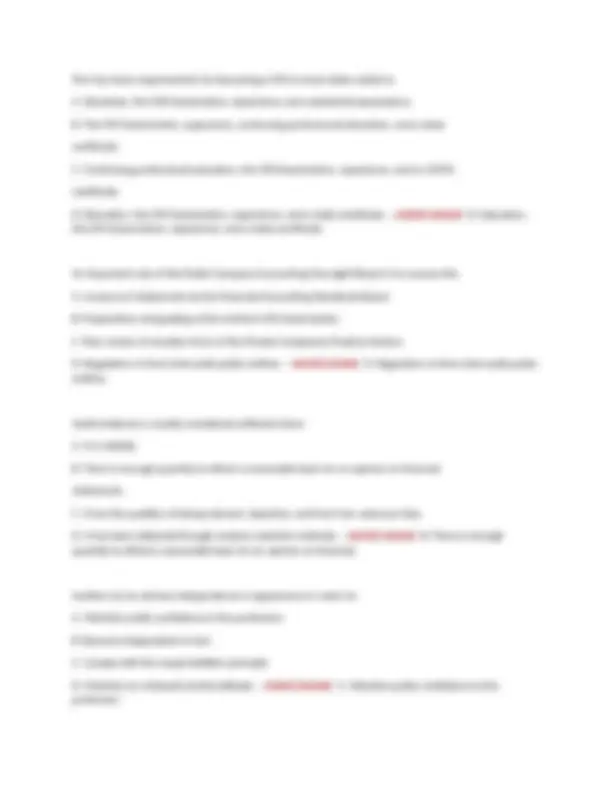
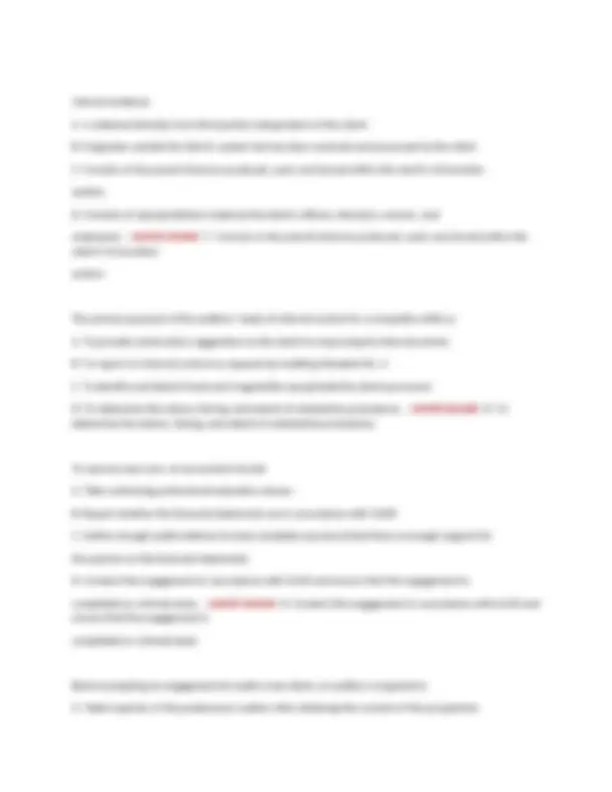
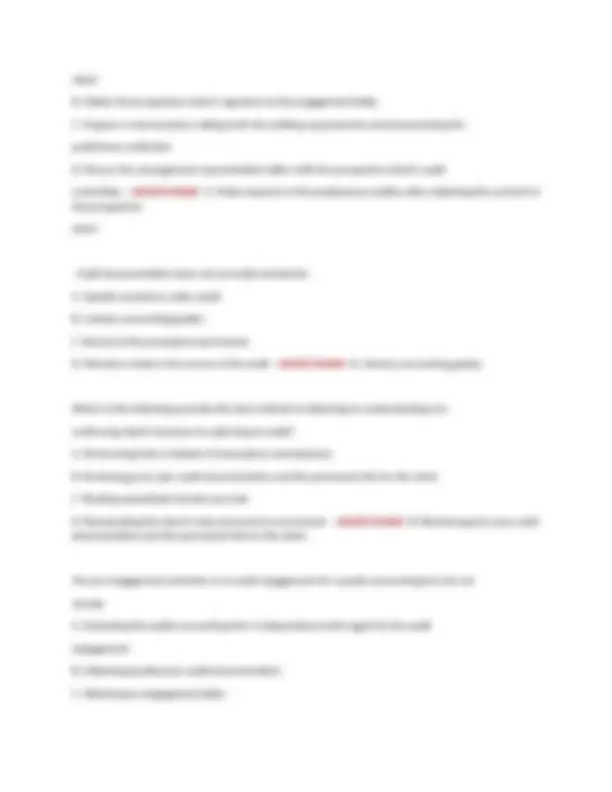
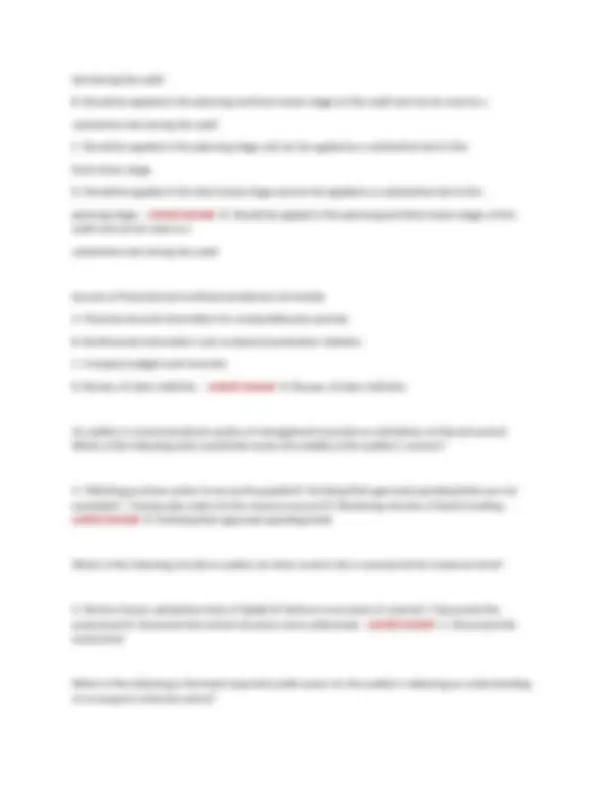
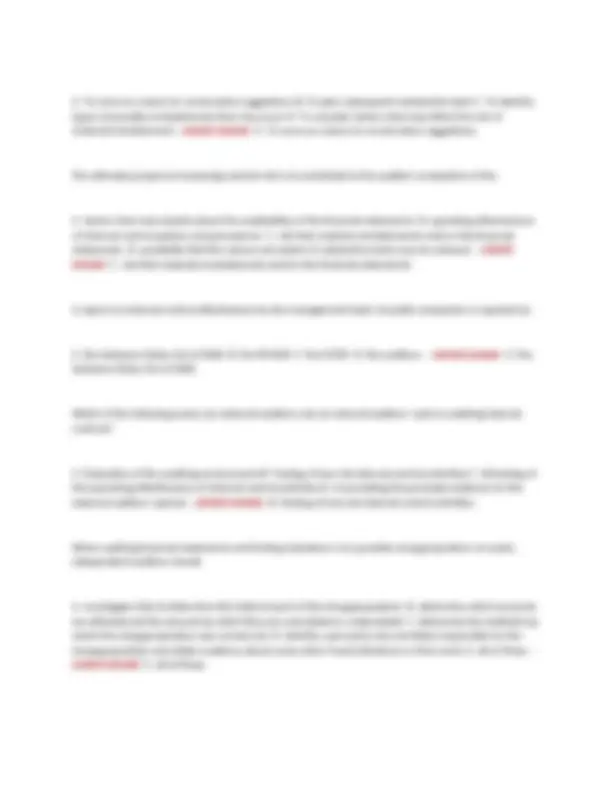
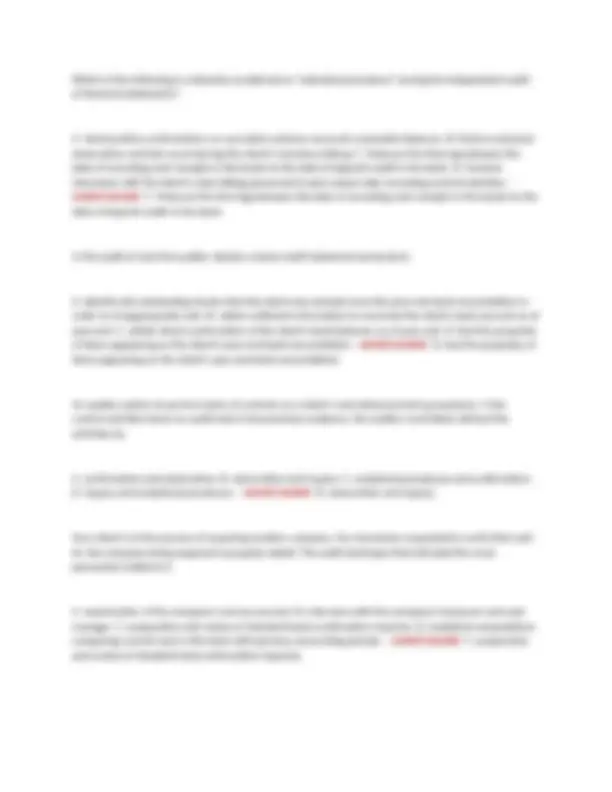
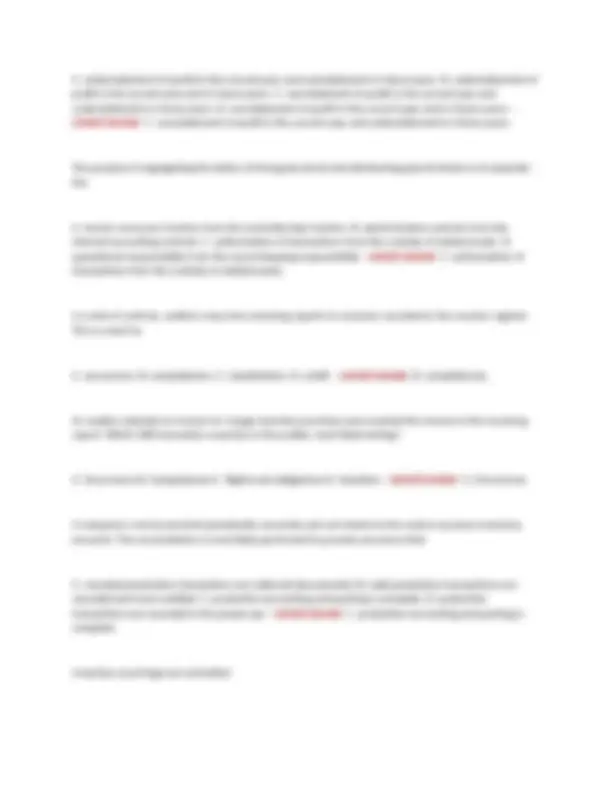
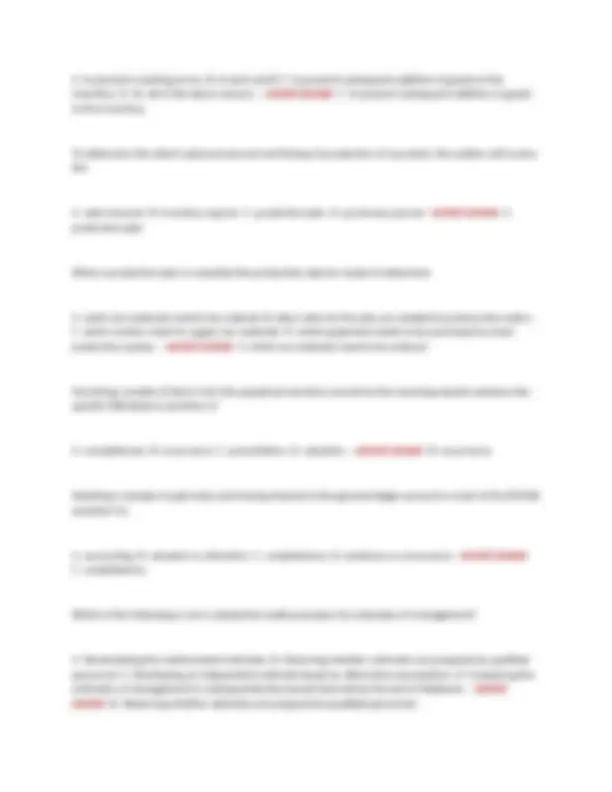
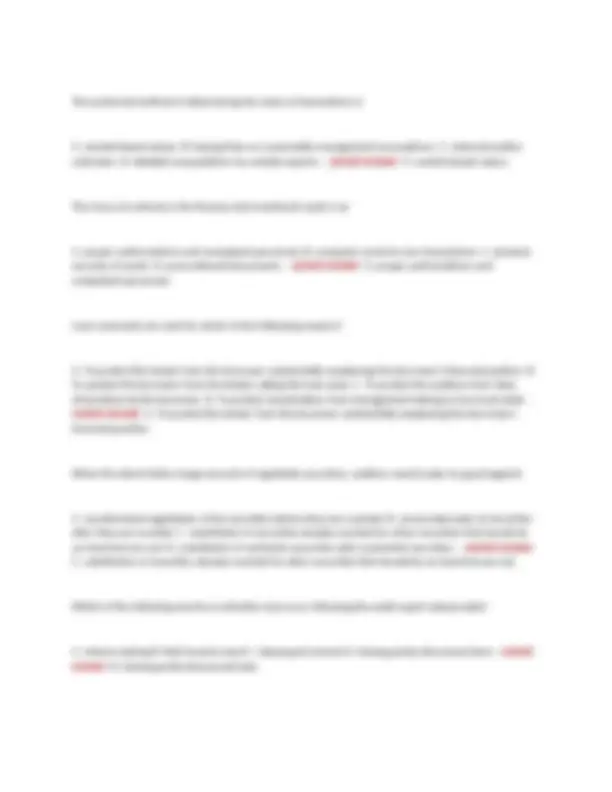
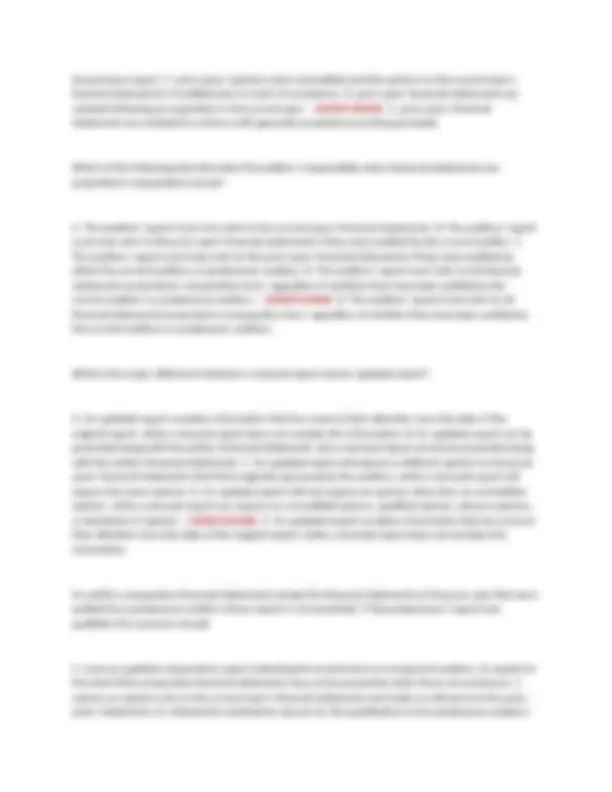
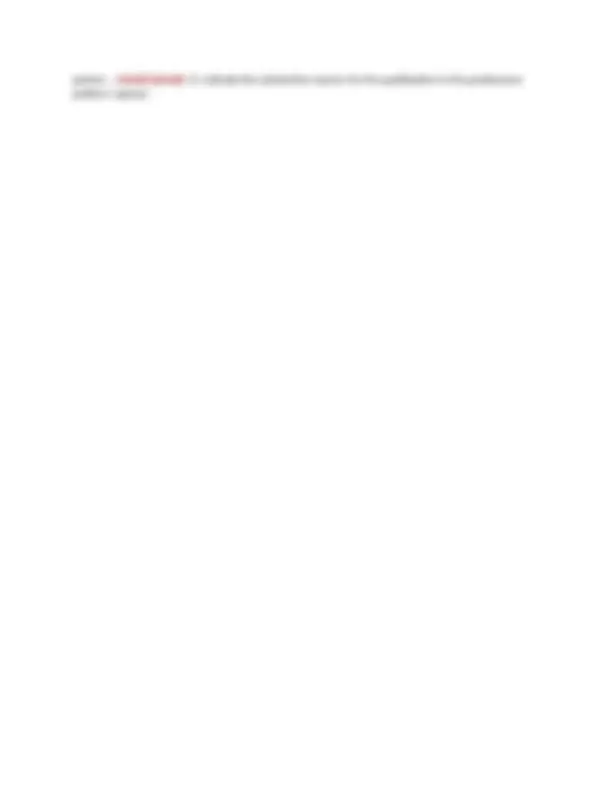


Study with the several resources on Docsity

Earn points by helping other students or get them with a premium plan


Prepare for your exams
Study with the several resources on Docsity

Earn points to download
Earn points by helping other students or get them with a premium plan
Community
Ask the community for help and clear up your study doubts
Discover the best universities in your country according to Docsity users
Free resources
Download our free guides on studying techniques, anxiety management strategies, and thesis advice from Docsity tutors
Auditing Final Test Bank/Auditing Final Test Bank
Typology: Exams
1 / 19

This page cannot be seen from the preview
Don't miss anything!












Which of the following is the essential purpose of the audit function? A. Detection of fraud. B. Examination of individual transactions to certify their validity. C. Determination of whether the client's financial statement assertions are fairly stated. D. Assurance of the consistent application of correct accounting procedures - correct answer C. Determination of whether the client's financial statement assertions are fairly stated. Which of the following best describes the primary role and responsibility of the independent external auditor? A. Produce a company's annual financial statements and notes. B. Express an opinion on the fairness of a company's annual financial statements and footnotes. C. Provide business consulting advice to audit clients. D. Obtain an understanding of the client's internal control structure and give management a report about control problems and deficiencies. - correct answer B. Express an opinion on the fairness of a company's annual financial statements and footnotes. Because of the risk of material misstatement, an audit of financial statements in accordance with generally accepted auditing standards should be planned and performed with an attitude of A. Objective judgment. B. Independent integrity. C. Professional skepticism. D. Impartial conservatism. - correct answer C. Professional skepticism Which of the following best describes assurance services?
A. Independent professional services that report on the client's financial statements. B. Independent professional services that improve the quality of information for decision makers. C. Independent professional services that report on specific written management assertions. D. Independent professional services that improve the client's operations. - correct answer B. Independent professional services that improve the quality of information for decision makers. An attestation engagement is one in which a CPA is engaged to A. Issue a report on subject matter or an assertion about the subject matter that is the responsibility of another party. B. Provide tax advice or prepare a tax return based on financial information the CPA has not audited or reviewed. C. Testify as an expert witness in accounting, auditing, or tax matters, given certain stipulated facts. D. Assemble prospective financial statements based on the assumptions of the entity's management without expressing any assurance. - correct answer A. Issue a report on subject matter or an assertion about the subject matter that is the responsibility of another party. The Sarbanes-Oxley Act of 2002 requires that the key company officials certify the financial statements. Certification means that the company CEO and CFO must sign a statement indicating A. They have read the financial statements. B. They are not aware of any false or misleading statements (or any key omitted disclosures) C. They believe that the financial statements present an accurate picture of the company's financial condition. D. All of the above. - correct answer D. All of the above.
Internal evidence A. Is obtained directly from third parties independent of the client. B. Originates outside the client's system but has been received and processed by the client. C. Consists of documents that are produced, used, and stored within the client's information system. D. Consists of representations made by the client's officers, directors, owners, and employees. - correct answer C. Consists of documents that are produced, used, and stored within the client's information system. The primary purpose of the auditors' study of internal control for a nonpublic entity is: A. To provide constructive suggestions to the client for improving its internal control. B. To report on internal control as required by Auditing Standard No. 5. C. To identify and detect fraud and irregularities perpetrated by client personnel. D. To determine the nature, timing, and extent of substantive procedures. - correct answer D. To determine the nature, timing, and extent of substantive procedures. To exercise due care, an accountant should A. Take continuing professional education classes. B. Report whether the financial statements are in accordance with GAAP. C. Gather enough audit evidence to have complete assurance that there is enough support for the opinion on the financial statements. D. Conduct the engagement in accordance with GAAS and ensure that the engagement is completed on a timely basis. - correct answer D. Conduct the engagement in accordance with GAAS and ensure that the engagement is completed on a timely basis. Before accepting an engagement to audit a new client, an auditor is required to A. Make inquiries of the predecessor auditor after obtaining the consent of the prospective
client. B. Obtain the prospective client's signature to the engagement letter. C. Prepare a memorandum setting forth the staffing requirements and documenting the preliminary audit plan. D. Discuss the management representation letter with the prospective client's audit committee. - correct answer A. Make inquiries of the predecessor auditor after obtaining the consent of the prospective client.
. Audit documentation does not normally include the A. Specific assertions under audit. B. Industry accounting guides. C. Record of the procedures performed. D. Decisions made in the course of the audit - correct answer B. Industry accounting guides. Which of the following provides the best method of obtaining an understanding of a continuing client's business for planning an audit? A. Performing tests of details of transactions and balances. B. Reviewing prior year audit documentation and the permanent file for the client. C. Reading specialized industry journals. D. Reevaluating the client's internal control environment. - correct answer B. Reviewing prior year audit documentation and the permanent file for the client. The pre-engagement activities of an audit engagement for a public accounting firm do not include A. Evaluating the public accounting firm's independence with regard to the audit engagement. B. Obtaining predecessor audit documentation. C. Obtaining an engagement letter.
A. Unfavorable industry conditions. B. Lack of working capital. C. High liquidity. D. Slow customer collections. - correct answer C. High liquidity An auditor assesses the risk of material misstatement because it A. Is relevant to the auditor's understanding of the control environment. B. Provides assurance that the auditor's overall materiality levels are appropriate. C. Indicates to the auditor where inherent risk may be the greatest. D. Affects the level of detection risk that the auditor may accept. - correct answer D. Affects the level of detection risk that the auditor may accept. Which of the following statements best describes auditors' responsibility to detect errors and frauds? A. Auditors should design an audit to provide reasonable assurance of detecting errors and frauds that are material to the financial statements. B. Auditors are responsible to detect material errors but have no responsibility to detect material frauds that are concealed through employee collusion or management override of the internal control structure. C. Auditors have no responsibility to detect errors and frauds unless analytical procedures or tests of transactions identify conditions causing a reasonably prudent auditor to suspect that the financial statements were materially misstated. D. Auditors have no responsibility to detect errors and frauds because auditors are not insurers and an audit does not constitute a guarantee. - correct answer A. Auditors should design an audit to provide reasonable assurance of detecting errors and frauds that are material to the financial statements. Generally accepted auditing standards state that analytical procedures A. Should be applied in the planning and final review stages of the audit and as a substantive
test during the audit. B. Should be applied in the planning and final review stages of the audit and can be used as a substantive test during the audit. C. Should be applied in the planning stage and can be applied as a substantive test in the final review stage. D. Should be applied in the final review stage and can be applied as a substantive test in the planning stage. - correct answer B. Should be applied in the planning and final review stages of the audit and can be used as a substantive test during the audit. Sources of financial and nonfinancial data do not include A. Financial account information for comparable prior periods. B. Nonfinancial information such as physical production statistics. C. Company budgets and forecasts. D. Bureau of Labor statistics. - correct answer D. Bureau of Labor statistics. An auditor is concerned about a policy of management override as a limitation of internal control. Which of the following tests would best assess the validity of the auditor's concern? A. Matching purchase orders to accounts payable B. Verifying that approved spending limits are not exceeded C. Tracing sales orders to the revenue account D. Reviewing minutes of board meeting - correct answer B. Verifying that approved spending limits Which of the following should an auditor do when control risk is assessed at the maximum level? A. Perform fewer substantive tests of details B. Perform more tests of controls C. Document the assessment D. Document the control structure more extensively - correct answer C. Document the assessment Which of the following is the least important audit reason for the auditor's obtaining an understanding of a company's internal control?
Which of the following is ordinarily considered an "extended procedure" during the independent audit of financial statements? A. Send positive confirmations on recorded customer accounts receivable balances. B. Perform physical observation and test count during the client's inventory taking. C. Measure the time lag between the date of recording cash receipts in the books to the date of deposit credit in the bank. D. Conduct interviews with the client's sales billing personnel to learn about sales recording control activities. - correct answer C. Measure the time lag between the date of recording cash receipts in the books to the date of deposit credit in the bank. In the audit of cash the auditor obtains a bank cutoff statement primarily to A. identify old outstanding checks that the client may exclude from the year-end bank reconciliation in order to misappropriate cash. B. obtain sufficient information to reconcile the client's bank account as of year-end. C. obtain direct confirmation of the client's bank balances as of year-end. D. test the propriety of items appearing on the client's year-end bank reconciliation - correct answer D. test the propriety of items appearing on the client's year-end bank reconciliation An auditor wishes to perform tests of controls on a client's cash disbursements procedures. If the control activities leave no audit trail of documentary evidence, the auditor most likely will test the activities by A. confirmation and observation. B. observation and inquiry. C. analytical procedures and confirmation. D. inquiry and analytical procedures. - correct answer B. observation and inquiry. Your client is in the process of acquiring another company. You have been requested to verify that cash for the company being acquired is properly stated. The audit technique that will yield the most persuasive evidence is A. examination of the company's escrow account. B. interview with the company's treasurer and cash manager. C. preparation and review of standard bank confirmation inquiries. D. analytical computations comparing current cash in the bank with previous accounting periods. - correct answer C. preparation and review of standard bank confirmation inquiries.
Most fraud investigators utilize the fraud triangle theory. A new theory called the fraud diamond has been proposed. Which of the following is an element of the fraud diamond and is not an element of the fraud triangle? A. Motive B. Opportunity C. Capability D. Liquidity - correct answer C. Capability Custody of inventory is transferred to the shipping area upon authorization of A. the customer order. B. the shipping order. C. the invoice. D. the purchase order. - correct answer B. the shipping order. The sum of customers' unpaid balances that is compared to the general ledger balance comes from A. a total of sales invoices. B. a total of shipping orders. C. the sales journal. D. the accounts receivable trial balance. - correct answer D. the accounts receivable trial balance. The file that contains sales transactions that were initiated in the system but are not yet completed is the A. credit check file. B. sales detail. C. inventory master. D. pending order master. - correct answer D. pending order master. The assertion that auditors will probably emphasize in the revenue and collection cycle is A. occurrence. B. completeness. C. accuracy. D. classification. - correct answer A. occurrence. Confirmations of accounts receivable provide the most evidence for which of the following assertions? A. Existence. B. Valuation or allocation. C. Rights and obligations. D. Completeness. - correct answer A. Existence
A. understatement of profit in the current year and overstatement in future years. B. understatement of profit in the current year and in future years. C. overstatement of profit in the current year and understatement in future years. D. overstatement of profit in the current year and in future years. - correct answer C. overstatement of profit in the current year and understatement in future years. The purpose of segregating the duties of hiring personnel and distributing payroll checks is to separate the A. human resources function from the controllership function. B. administrative controls from the internal accounting controls. C. authorization of transactions from the custody of related assets. D. operational responsibility from the record keeping responsibility - correct answer C. authorization of transactions from the custody of related assets. In a test of controls, auditors may trace receiving reports to vouchers recorded in the voucher register. This is a test for A. occurrence. B. completeness. C. classification. D. cutoff. - correct answer B. completeness. An auditor selected an invoice for a large inventory purchase and vouched the invoice to the receiving report. Which ASB transaction assertion is the auditor most likely testing? A. Occurrence B. Completeness C. Rights and obligations D. Valuation - correct answer A. Occurrence A company's cost accountant periodically reconciles job cost sheets to the work-in-process inventory accounts. This reconciliation is most likely performed to provide assurance that A. recorded production transactions are valid and documented. B. valid production transactions are recorded and none omitted. C. production accounting and posting is complete. D. production transactions are recorded in the proper per - correct answer C. production accounting and posting is complete. Inventory count tags are controlled
A. to prevent counting errors. B. to test cutoff. C. to prevent subsequent addition of goods to the inventory. D. for all of the above reasons. - correct answer C. to prevent subsequent addition of goods to the inventory. To determine the client's planned amount and timing of production of a product, the auditor will review the A. sales forecast. B. inventory reports. C. production plan. D. purchases journal - correct answer C. production plan. When a production plan is complete the production planner needs to determine A. what raw materials need to be ordered. B. labor rates for the jobs are needed to produce the orders. C. which vendors need to supply raw materials. D. what equipment needs to be purchased to meet production quotas. - correct answer A. what raw materials need to be ordered. Vouching a sample of items from the perpetual inventory records to the receiving reports achieves the specific ASB balance assertion of A. completeness. B. occurrence. C. presentation. D. valuation. - correct answer B. occurrence. Selecting a sample of paid notes and tracing interest to the general ledger account is a test of the PCAOB assertion for A. accounting. B. valuation or allocation. C. completeness. D. existence or occurrence - correct answer C. completeness. Which of the following is not a substantive audit procedure for estimates of management? A. Recalculating the mathematical estimate. B. Observing whether estimates are prepared by qualified personnel. C. Developing an independent estimate based on alternative assumptions. D. Comparing the estimates of management to subsequently discovered facts before the end of fieldwork. - correct answer B. Observing whether estimates are prepared by qualified personnel.
Why should auditors be particularly concerned with "miscellaneous", "other", and "clearing" accounts classified as revenues or expenses? A. These accounts are likely to relate to going-concern matters. B. These accounts are often more difficult to audit using normal substantive procedures. C. These accounts may represent attempts of earnings management. D. These accounts are likely to require the assistance of a specialist. - correct answer C. These accounts may represent attempts of earnings management. What is the primary purpose of obtaining written representations? A. To provide auditors with substantive evidence of important assertions B. To impress upon management its primary responsibility for the financial statements C. To allow auditors to communicate important internal control deficiencies to management D. To allow auditors to communicate important suggestions for improvement to management - correct answer B. To impress upon management its primary responsibility for the financial statements An engagement quality review by a second partner of the audit documentation and financial statements is performed to ensure that the: A. "to-do lists" are reviewed and cleared. B. audit plan procedures are "signed off." C. tick-mark notations are cleared. D. audit work meets the quality standards of the firm. - correct answer D. audit work meets the quality standards of the firm. A partner of the accounting firm who has not been involved in the audit performs an engagement quality review of documentation. This review usually focuses on A. the fair presentation of the financial statements in conformity with GAAP. B. irregularities involving the client's management and its employees. C. the materiality of the adjusting entries proposed by the audit staff. D. the communication of internal control deficiencies to the client's audit committee (or those charged with governance). - correct answer A. the fair presentation of the financial statements in conformity with GAAP Analytical procedures performed near the end of an audit generally include
A. considering unusual or unexpected account balances that were not previously identified. B. performing tests of transactions to corroborate management's financial statement assertions. C. gathering evidence concerning account balances that have not changed from the prior year. D. retesting control activities that appeared to be ineffective during the assessment of control risk. - correct answer A. considering unusual or unexpected account balances that were not previously identified. Auditors are required to reference consistency in their report when there are changes in A. accounting estimates. B. the format of the Statement of Cash Flows. C. the classification of financial statement amounts. D. accounting principles. - correct answer D. accounting principles. When an entity will not permit inquiry of outside legal counsel, the auditors' report on the entity's financial statements will ordinarily contain a(n) A. disclaimer of opinion. B. qualified opinion referencing a departure from generally accepted accounting principles. C. unmodified opinion with an additional paragraph. D. adverse opinion. - correct answer A. disclaimer of opinion. If management fails to provide adequate justification for a change from one generally accepted accounting principle to another, the auditors should A. add an additional paragraph and express a qualified or an adverse opinion on the entity's financial statements for lack of conformity with generally accepted accounting principles. B. disclaim an opinion on the entity's financial statements because of uncertainty. C. disclose the matter in an additional paragraph but not modify the opinion paragraph on the entity's financial statements. D. neither modify the opinion on the entity's financial statements nor disclose the matter because both principles are generally accepted accounting principles. - correct answer A. add an additional paragraph and express a qualified or an adverse opinion on the entity's financial statements for lack of conformity with generally accepted accounting principles. When reporting on comparative financial statements, auditors ordinarily should modify their previously expressed opinion on the prior-years' financial statements if the A. prior-years' financial statements are restated to conform with generally accepted accounting principles. B. auditors were predecessor auditors who have been requested by a former client to reissue
opinion. - correct answer D. indicate the substantive reasons for the qualification in the predecessor auditors' opinion.